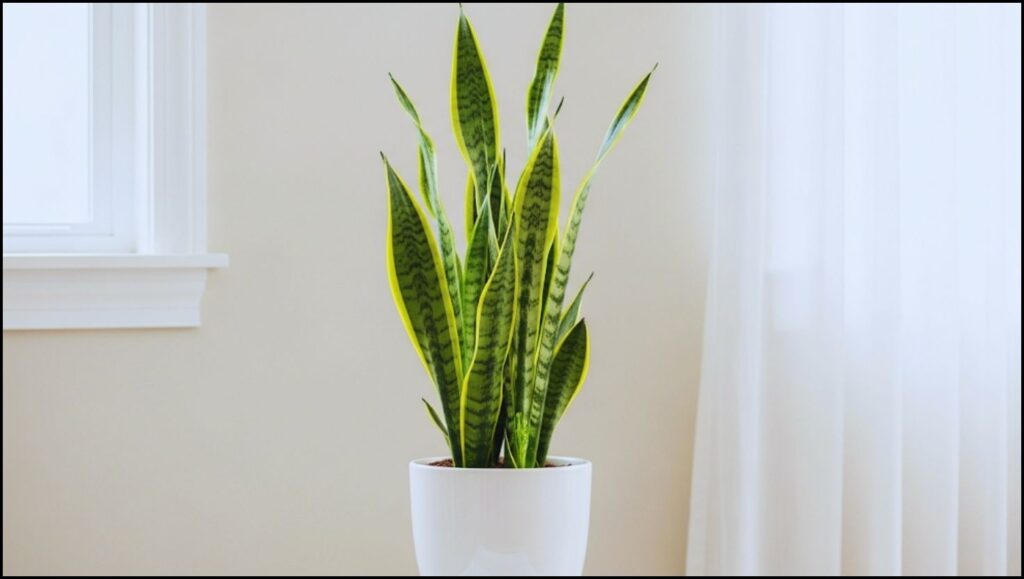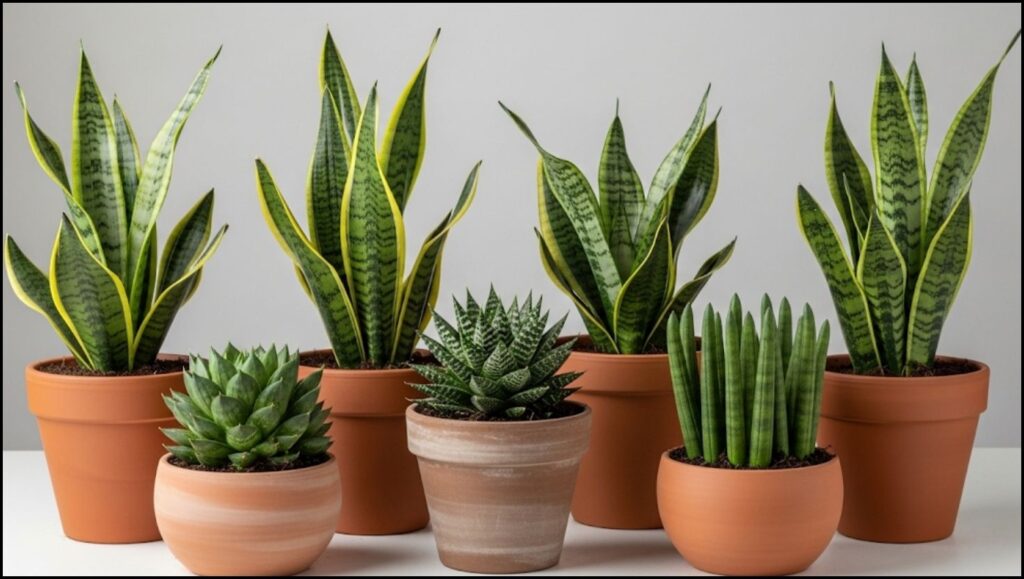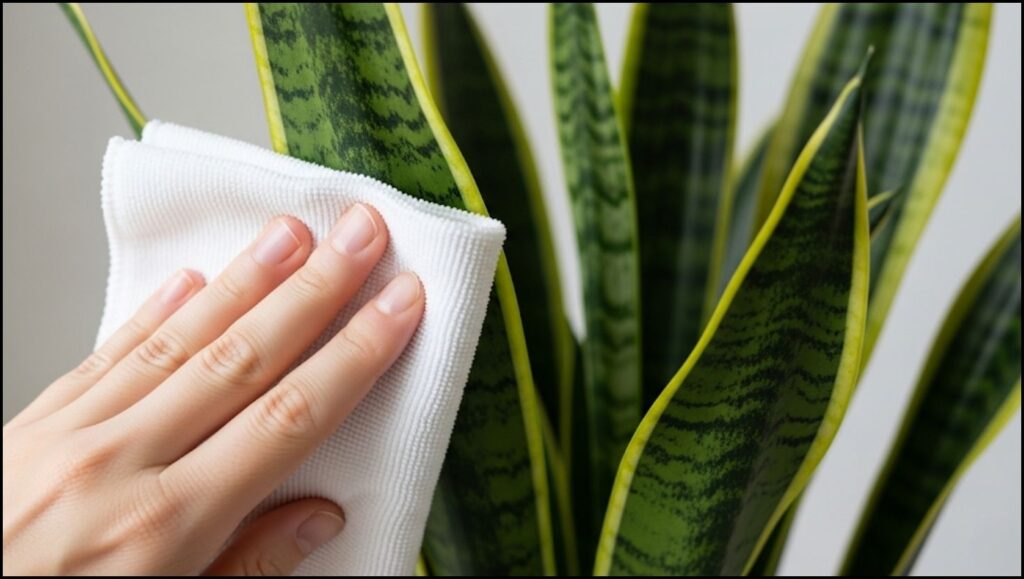
There is a certain quiet confidence to the snake plant. With its striking, architectural leaves that stand tall and true, it brings a touch of modern, sculptural elegance to any room it graces. Known botanically as Dracaena trifasciata, this unflappable houseplant is the very definition of resilient style, making it a perfect companion for both seasoned gardeners and those just discovering their green thumb. In this guide, we will explore everything you need to know about how to take care of a snake plant indoors, moving beyond simple survival to help your plant truly thrive. Let’s cultivate a space that is not only beautiful but also alive.
Quick Care Essentials
Here are the foundational secrets to a happy snake plant:
- Embrace Neglect: Water only when the soil is completely dry to the touch, roughly every 2-6 weeks. Overwatering is its only real enemy.
- Adaptable Light: While it tolerates low light, it thrives in medium to bright, indirect sunlight.
- Drainage is Key: Use a fast-draining cactus or succulent soil mix and a pot with ample drainage holes.
- Dust Occasionally: Wipe the leaves with a damp cloth every few months to keep them breathing and looking their best.
Why Every Well-Appointed Home Deserves a Snake Plant
Beyond its handsome appearance, the snake plant is a hardworking addition to your home. It’s celebrated for its air-purifying qualities, proven to filter common indoor pollutants like formaldehyde, xylene, and toluene from the air. According to research highlighted by the Clemson Cooperative Extension, having plants like Dracaena in our living spaces can contribute to a healthier indoor environment. In my own home, I appreciate them not just for this service but for their sheer versatility. A tall snake plant can anchor a room’s corner, while a compact variety can bring a splash of life to a bookshelf.
Choosing Your Perfect Companion: Exploring Snake Plant Varieties
While the classic tall, yellow-edged variety is iconic, the world of snake plant varieties is wonderfully diverse. Choosing the right one is like selecting a piece of living sculpture for your home.
- Dracaena trifasciata ‘Laurentii’: This is the quintessential snake plant, featuring tall, sword-like leaves of deep green edged in a creamy yellow band. It’s a classic for a reason and provides wonderful vertical interest.
- Dracaena trifasciata ‘Zeylanica’: Similar in form to ‘Laurentii’ but with a more subtle beauty, its leaves are marked with wavy, horizontal bands of silvery green and dark green.
- Dracaena trifasciata ‘Hahnii’ (Bird’s Nest Snake Plant): For smaller spaces, this is my go-to recommendation. It grows in a compact, vase-like rosette, rarely exceeding 6-8 inches in height. The ‘Golden Hahnii’ cultivar, with its bright yellow variegation, is particularly lovely.
- Dracaena angolensis (formerly Sansevieria cylindrica): This variety is truly unique, with round, spear-like leaves that can be braided or left to grow naturally for a fan-like effect. It’s a true conversation starter.

The Foundation of Success: Potting and Soil
A snake plant’s happiness begins at its roots. These plants are native to arid regions of West Africa and are susceptible to root rot, so providing the right environment is non-negotiable.
Choosing the Right Pot
I almost always recommend terracotta pots for snake plants. The porous clay allows soil to dry out more evenly, providing a crucial safeguard against waterlogging. Whatever material you choose, ensure it has at least one large drainage hole. Select a pot that is relatively snug; snake plants seem to enjoy being slightly root-bound and often won’t produce new leaves until their roots have filled their container.
The Perfect Soil Blend
Do not use standard potting soil straight from the bag, as it retains too much moisture. Instead, opt for a commercial cactus or succulent mix. To create your own superior blend, which I prefer for its perfect aeration, combine:
- 2 parts standard potting soil
- 1 part perlite or pumice (for aeration)
- 1 part coarse sand or fine horticultural grit (for drainage)
This mixture allows water to flow through freely while providing just enough substance for the roots to anchor themselves.
TOOLS AND MATERIALS BOX:
- Pot: Terracotta or ceramic with a large drainage hole.
- Soil: A fast-draining cactus/succulent mix or your own custom blend.
- Amendments: Perlite or pumice, coarse sand.
- Gloves: Optional, but helpful.
- Trowel: For scooping soil.
Finding the Sweet Spot: Snake Plant Light Requirements
Here is where the snake plant’s legendary toughness shines. It can survive in the low-light corners of your home where other plants falter, making it an excellent choice for hallways or north-facing rooms. However, survival is not the same as thriving.
A common mistake I see is relegating a snake plant to a dark corner and expecting it to flourish. While it will live, it won’t grow much. For robust growth and the most vibrant leaf coloring, place your plant in a spot that receives several hours of bright, indirect sunlight each day. An east-facing window that gets gentle morning sun is ideal. It will even tolerate some direct sun, but be mindful that harsh, direct afternoon sun can scorch its leaves.
The Art of Watering: Less Is Truly More
If you remember one thing about how to take care of a snake plant indoors, let it be this: do not overwater. This is the single fastest way to harm this otherwise indestructible plant. Their succulent leaves and rhizomes (underground stems) are designed to store water for long periods.
Follow the “drench and dry” method.
- Check the soil. Don’t just touch the surface; insert your finger about two inches deep. Is it completely dry? If you feel any moisture at all, wait longer.
- If it’s bone dry, move the plant to a sink or tub and water it thoroughly until water runs freely from the drainage hole. This ensures the entire root ball is hydrated.
- Allow the pot to drain completely for 15-20 minutes before returning it to its saucer. Never let the plant sit in a saucer full of water.
In winter, when the plant’s growth slows, you’ll need to water even less frequently—perhaps only once a month or even less, depending on your home’s conditions.
The Joy of More: A Simple Guide to Propagating Snake Plants
One of the great pleasures of gardening is creating new plants from old ones, and propagating snake plants is remarkably simple. It’s a wonderful way to expand your collection or share with friends.
There are two primary methods:
Method 1: Leaf Cuttings in Water
- Using a clean, sharp knife, cut a healthy leaf from the mother plant.
- You can place the whole leaf in water or cut it into 2- to 3-inch sections. If sectioning, make a small inverted ‘V’ cut at the bottom of each piece to help you remember which end is the bottom—roots will only grow from this end.
- Place the bottom end of the cutting(s) in a jar with an inch or two of clean water.
- Place the jar in indirect light and change the water weekly. Roots should begin to appear in several weeks to a few months.
- Once the roots are about an inch long, you can pot the cutting in soil.
Method 2: Leaf Cuttings in Soil
- Follow steps 1 and 2 from the water method.
- Allow the cuttings to sit out for a day or two to let the cut ends “callus” or dry over. This helps prevent rot.
- Dip the bottom ends in rooting hormone (optional, but it can speed things up).
- Insert the cuttings about an inch deep into a pot of moist, free-draining soil.
- Keep the soil lightly moist (but not wet) and wait. New pups (baby plants) will eventually sprout from the soil at the base of the cutting. This method is slower but often produces stronger plants.
Troubleshooting and Common Questions
Even the toughest plants can have an off day. Here’s how to diagnose common issues.
- Yellowing Leaves: This is almost always a sign of overwatering. Check the soil moisture and allow the plant to dry out completely.
- Mushy Base: A serious sign of root rot from excessive water. You may need to unpot the plant, cut away any black, mushy roots, and repot in fresh, dry soil.
- Wrinkled Leaves: This is a sign of thirst. The plant is using up its water stores. Give it a thorough watering.
- Pests: Snake plants are highly pest-resistant, but they can occasionally attract mealybugs or spider mites. A simple wipe-down with a cloth dipped in rubbing alcohol or insecticidal soap will usually solve the problem. The University of Florida IFAS Extension offers excellent guidance on identifying and treating common houseplant pests.

A Final Word of Encouragement
The enduring charm of the snake plant lies in its beautiful paradox: it is a plant of striking drama and quiet simplicity. It asks for so little but gives back so much, purifying your air and elevating your decor with its architectural form. By understanding its simple needs—bright, indirect light, dry soil, and the occasional watering—you are perfectly equipped to cultivate a healthy, stunning specimen. You now know exactly how to take care of a snake plant indoors. Embrace its easygoing nature, give it a good home, and enjoy the effortless elegance it brings to your life for years to come.
How Often Should You Watering a Peace Vine? A Comprehensive Guide
